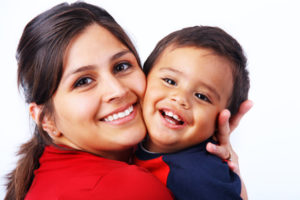Understanding the Different Ways of Bonding and Communicating with Your Child
 The main predictor of how well your child will do in school and in life is the strength of the relationship he or she has with you, the parent or primary caretaker. This relationship impacts your child’s future mental, physical, social, and emotional health. It is not founded on quality of care or parental love, but on the nonverbal emotional communication between child and parent known as the attachment bond. While it’s easiest to form this secure attachment bond with an infant, it can be formed at any time or at any age.
The main predictor of how well your child will do in school and in life is the strength of the relationship he or she has with you, the parent or primary caretaker. This relationship impacts your child’s future mental, physical, social, and emotional health. It is not founded on quality of care or parental love, but on the nonverbal emotional communication between child and parent known as the attachment bond. While it’s easiest to form this secure attachment bond with an infant, it can be formed at any time or at any age.
Why is the attachment bond so important?
A landmark report, published in 2000 by The Committee on Integrating the Science of Early Childhood Development, identified how crucial the attachment bond is to a child’s development. This form of communication affects the way your child develops mentally, physically, intellectually, emotionally, and socially. While attachment occurs naturally as you, the parent or caretaker, care for your baby’s needs, the quality of the attachment bond varies.
- A secure attachment bond ensures that your child will feel secure, understood, and be calm enough to experience optimal development of his or her nervous system. Your child’s developing brain organizes itself to provide your child with the best foundation for life: a feeling of safety that results in eagerness to learn, healthy self-awareness, trust, and empathy.
- An insecure attachment bond fails to meet your child’s need for security, understanding, and calm, preventing the child’s developing brain from organizing itself in the best ways. This can inhibit emotional, mental, and even physical development, leading to difficulties in learning and forming relationships in later life.
Developing a secure attachment bond between you and your child, and giving your child the best start in life, does not require you to be a perfect parent. In fact, the 2000 study found that the critical aspect of the child–primary caretaker relationship is NOT based on quality of care, educational input, or even the bond of love that develops between parent and infant. Rather, it is based on the quality of the nonverbal communication process that takes place between you and your child.
Your baby needs more than love
As a parent or primary caretaker for your infant, you can follow all the traditional parenting guidelines, provide doting, around-the-clock care for your baby, and yet still not achieve a secure attachment bond. You can tend to your child’s every physical need, provide the most comfortable home, the highest quality nourishment, the best education, and all the material goods a child could wish for. You can hold, cuddle, and adore your child without creating the kind of attachment that fosters the best development for your child.
How is it possible to do such a good job of meeting a child’s physical needs and yet have a child that does not have a secure attachment and may suffer developmentally?
Read the full article to learn more about the difference between bonding and a “secure attachment bond” on the Helpguide.org website.
Source: Helpguide.org | What is Secure Attachment and Bonding?, https://www.helpguide.org/articles/parenting-family/what-is-secure-attachment-and-bonding.htm | © Helpguide.org. All rights reserved. Helpguide.org is a trusted non-profit guide to mental health and well-being.
Are you concerned about your child’s development? Care Coordinators can arrange a free 30 minute Care Consultation so you can explore options with an expert. We invite you to call our Care Coordinators at 650.688.3625 or email us at careteam@chconline.org to set up an initial Parent Consultation appointment.




